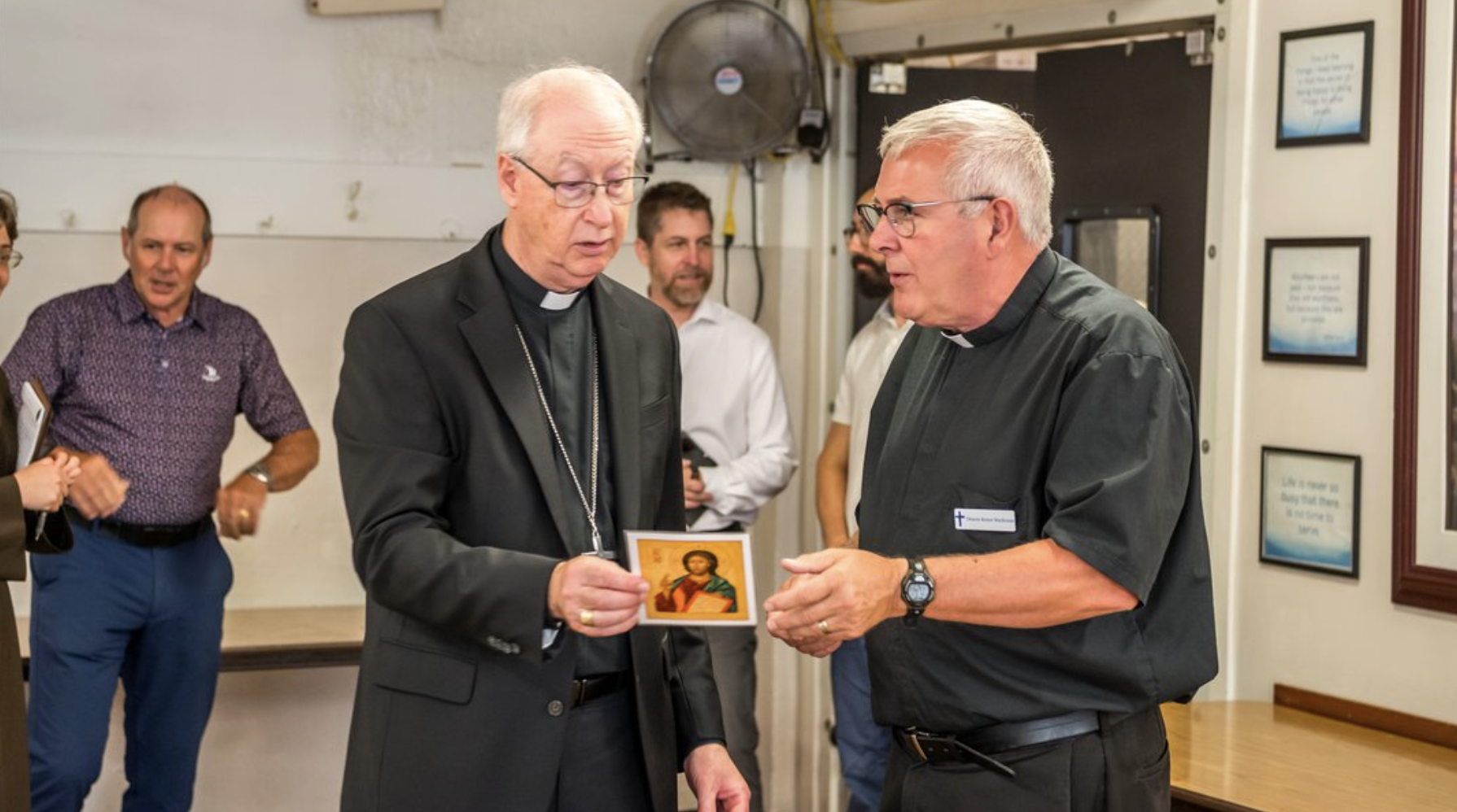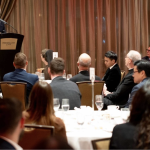VANCOUVER (CCN) — Complacency in the face of injustice can’t be the answer to the Downtown Eastside, Archbishop Richard Smith told The B.C. Catholic in his first interview with the newspaper since his installation almost six months ago.
“As a whole Archdiocese, we can’t see that as just a problem ‘over there,’” he said. “What do we, from our own perspectives and experiences, have to contribute to answering that need?”
The Archbishop stressed how urgent the problem is. “That area has been a reality for so long that the danger is taking it for granted — that it’ll just always be there. But no. These are broken individuals. How do we reach out?”

As many Vancouverites know, the Downtown Eastside’s reputation precedes it. Show the city to visitors and they’ll likely ask about the controversial neighbourhood. Archbishop Smith was no different, and his awareness of the area, coupled with the Church’s emphasis on the poor, inspired him to choose Sacred Heart Parish, made up of St. Paul and Sacred Heart churches, for his first pastoral visit.
“We know that the Lord draws close especially to the poor and the broken,” he said. “That’s why I wanted to be there first.”

While it confirmed many stereotypes about the neighbourhood, his visit also gave him hope. He was impressed by the variety of outreach being done by the Church “through the parishes, through associations that want to be there, some religious congregations, partnership with Providence Health Care – which is really committed to doing a lot of work with the poor and being with the vulnerable.”
Sacred Heart’s pastor, Father Ray Smith, and his fellow Claretian Fathers, relative newcomers to the archdiocese, also impressed him. “They’re giving some beautiful pastoral leadership,” he said. They are “bringing people together in wonderful ways. There’s new life happening in those communities now.”

Even still, a question hangs over the Archdiocese regarding its responsibility to the poorest of the poor: “What more can we do?” asked the archbishop.
“There’s no question the Church has to be there,” he said. “If people throughout the Archdiocese are thinking of renewal, I’m glad to hear that, it cannot be apart from a renewed emphasis on this area, or any other places where we encounter the poor today.”
“Every one of us is a beggar before God,” he said. Though we are materially wealthy and in possession of good education and good health, “we are creatures who depend totally on the providence and mercy of God.”
When we encounter the poor, “they reveal to us that fundamental truth, that apart from God we can do nothing, that we are loved not because of what we have, but because of who we are as his sons and daughters,” he said.

The archbishop describes the poor as “prophets” in a sense, exposing “what’s broken in society, and sometimes what’s broken in us,” while teaching compassion, patience, and humility. “Being with the poor requires you to set aside your own assumptions, your own pace, your own comfort. They slow us down. They make us human again.”
“They also teach what faith can look like in its most radical form. I’ve met people on the streets who, despite everything, still cling to hope, still pray, still believe that God is with them. That kind of faith can shake you. It’s pure, unfiltered faith.”

Conversation with Archbishop Smith
In addition to his thoughts on the Downtown Eastside, Archbishop Smith shared his impressions of the Church in Vancouver, reflections on prayer, and his optimism about the future of the archdiocese. The interview has been edited for clarity.
The B.C. Catholic: The inspiration for this interview was your pastoral visit to Sacred Heart. How was it?
Archbishop Smith: I think it’s important, first, just as a guiding principle, to know that the Holy Spirit has been at work in this Archdiocese, as throughout the whole Church, for a long, long time. This is a strong archdiocese. There’s been some wonderful episcopal leadership over the years, and it has that reputation of being strong, loving the Church, and wanting to serve the Gospel.
Coming in, I knew I’d have a lot to discover and learn about the goodness that’s already here. It’s never about starting something new. It’s about building on what’s already in place. That’s why I visit parishes, to see firsthand what’s happening.
Before coming here, I’d heard a lot about the Downtown Eastside, so I wanted to get there first. We know the Lord draws close especially to the poor and the broken.
In fact, that’s the heart of the recent apostolic exhortation, Pope Leo’s “Delexi Te,” where he says the renewal of the Church is inseparable from care for the poor, walking with the poor, and learning from them as our “silent teachers.” It’s to the poor that we have to look first if we’re going to talk about renewal.
That’s why my first parish visit was to St. Paul and Sacred Heart, right in that environment. It’s a sea of broken humanity. Yet what I found was an incredible variety of outreach the Archdiocese has been involved in for quite some time, through the parishes, associations, religious congregations, and Providence Health Care, which is doing so much with the poor and vulnerable. The Claretian Fathers recently arrived … my heavens, they’re giving beautiful pastoral leadership and bringing people together in wonderful ways. There’s new life happening in those communities now. Seeing that, plus The Door Is Open and the Men’s Shelter, was very edifying and encouraging.
But it still raises the question: What more can we do? Or do we need to do things differently? There’s no question the Church has to be there. If people throughout the Archdiocese are thinking of renewal, and I’m glad to hear that, it cannot be apart from renewed emphasis on this area or any other place where we encounter the poor today.

The B.C. Catholic: Is it both helpful and challenging, representing an extreme of what exists in the archdiocese?
Archbishop Smith: That’s a great way of putting it. The Downtown Eastside, in many ways, is the heart of what it means to be Church, but it’s not the entirety of what the Church does. We have our parishes, institutions, and many opportunities for people to grow in discipleship and love of the Lord. We also have this beautiful diversity of ethnic and cultural backgrounds. That’s both a challenge and an opportunity. The challenge for me is understanding cultures I haven’t lived in, and how we proclaim the Gospel so that it lands meaningfully within those contexts.
But the opportunity is that disciples from those very cultures can guide me and help the Gospel connect. Even as we look at that diversity, we all share a common question: Who are the poor among us? How do we reach them? That diversity finds particular concentration in the Downtown Eastside, many Indigenous people, many migrants who’ve come here and struggled, ending up on the street not knowing what to do.
As an archdiocese, we can’t see that as just a problem “over there.” What do we, from our own perspectives, have to contribute to answering that need? It’s urgent. That area’s been a reality for so long that the danger is taking it for granted, that it’ll just always be there. But no. These are broken individuals. How do we reach out?
The B.C. Catholic: In what other areas could we better align with the poor’s long-term potential and thriving?
Archbishop Smith: I’d take counsel on that. We have people with real expertise, substance abuse, mental health, housing. The question is, can those minds come together for meaningful conversation? I worry about siloed approaches: You deal with drugs. You deal with housing. You deal with mental health … without talking to one another. Can we create venues for collaboration where new answers emerge?
This could be one local opportunity for the Archdiocese to engage the synodal process launched by Pope Francis and picked up by Pope Leo: Conversations in the Spirit. It’s a simple but profound method: come together, pray, and ask how the Spirit is leading us closer to Christ and into mission. It would be beautiful for people to gather in prayer with their expertise and ask, “How is Jesus asking us to encounter the poor in ways that are life-giving, hope-giving, and transformative?”
The B.C. Catholic: One of your first initiatives was the Rosary for Peace. You also said at Upper Room that people sometimes pray too small. How should people pray?
Archbishop Smith: It starts with living what we believe. Do I live in a way that shows I really believe what the Church proclaims, that nothing is impossible with God? When we face situations we can’t figure out, in families, in the Downtown Eastside, that’s when we take God at his word. Jesus said, “ask.” “Don’t be afraid.” Ask according to God’s infinite ability, as Mary did when she visited Elizabeth. We need to pray with extraordinary faith: “Lord, let your Spirit fall. Do the wonders only you can do for your suffering people. Renew your Church, revive it, bring your people alive.” This applies locally and globally, for peace, for healing, for renewal.
The Church isn’t just an NGO; we are the Body of Christ. We turn to him, and through Mary, Queen of Peace, we intercede. At the cathedral, 400 or 500 people came for the Rosary for Peace on short notice. I want to do it every month, imploring the Blessed Mother to turn to her son. God answers in wondrous ways when we pray with extraordinary faith.
The B.C. Catholic: What stands out about Vancouver compared with your other experiences across Canada?
Archbishop Smith: One thing that struck me, and I mentioned this at my installation, is the geography. We’re bounded by mountains, border, and ocean. That could create a closed mentality – “let’s look after ourselves.” But it also offers a call to be missionary to the world gathered here. People here have zeal for the Gospel. Upper Room showed that. At the same time, secularism is strong. Catholics are a minority, and “Nones” are growing. Yet among young adults, there’s a resurgence of faith, people discovering Jesus, being baptized, finding purpose. That’s the Holy Spirit at work.
The B.C. Catholic: How can the Church offer young people hope for the future?
Archbishop Smith: By announcing Jesus. We don’t know what the future holds, but we know the One who holds it. Through the Resurrection, Jesus transcends time. He’s already in our future, shaping our present. That gives peace. An elderly nun once told me, “The Lord arranges all things without error.” When we’re anxious about life, we can rest in that truth.
The B.C. Catholic: Six months in, what’s on the horizon that excites you?
Archbishop Smith: Planning. Archbishop Miller laid a strong foundation – evangelization, renewal, infrastructure. We have capable, faith-filled people here. I want to gather minds, identify challenges, and envision the next 10–20 years together. That’s energizing.
The B.C. Catholic: What’s been the biggest lesson so far?
Archbishop Smith: The same one I learn daily: fall on my knees and give it all over to Jesus. My strength is limited. Lord, fill me, carry the Archdiocese forward. Spend time with the Lord in prayer, especially before the Blessed Sacrament, and let the Holy Spirit remind me who Jesus is and who I am. It’s about extraordinary faith and trust.
The B.C. Catholic: Advice for those who struggle to do that?
Archbishop Smith: Just do it. Practice it. A nun once told me, “Stay close to Jesus and Mary.” Be deliberate: schedule prayer, place yourself before the Lord, and say, “Be it done,” as Mary did. Let him work in you, reshape you for salvation. Live holiness first. Out of that comes mission. Just do it.




